JOHN WRAY
1841-1913 LAYTON CEMETERY REGISTRAR 1873-1913
Compiled by Colin Reed. Published September 2023.
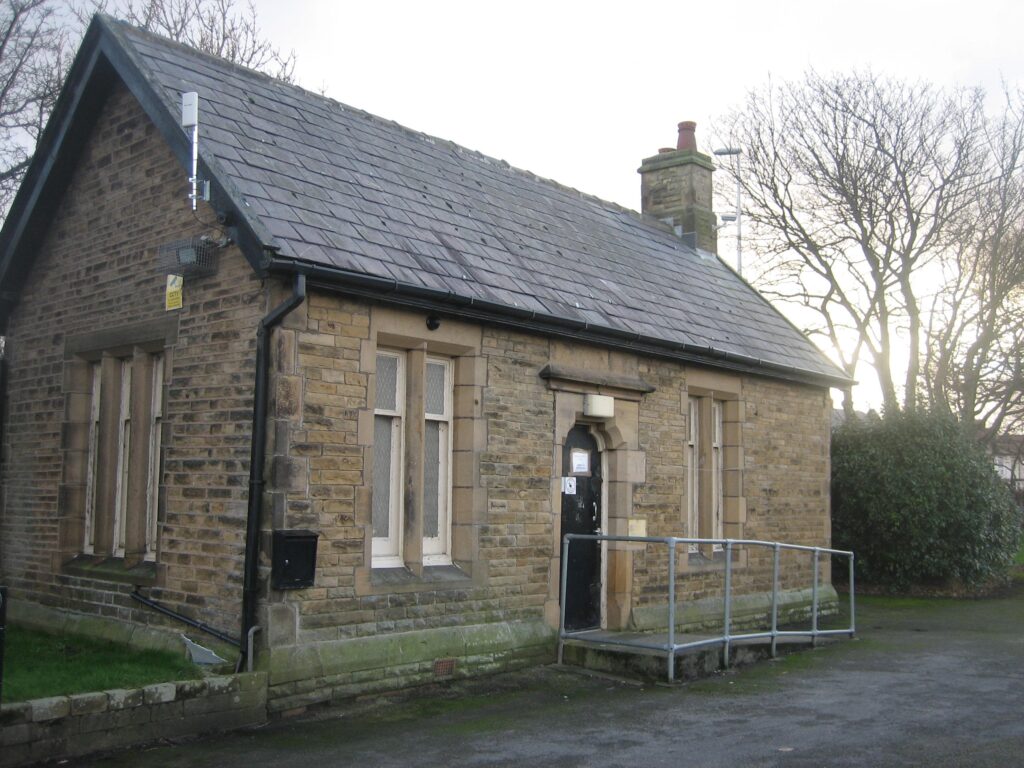
The accommodation, as it is today, provided, in the beginning, for the resident Registrar at the cemetery site in Layton, Blackpool. Thanks to Denys Barber of the Friends of Layton Cemetery for this image. There is a picture of John Wray, taken from the newspapers however this, as a download, is poor quality and is included, until a better image can be found, with his obituary, further down the page.
As Layton Cemetery’s First Warden and Registrar in Blackpool, it was a post that John Wray held for forty years from being appointed on the apportioning of the land for the cemetery in 1873 at the age of 31 until his death in 1913, at the age of 71. As a married man with a family, and in business in his own right, John had come to Blackpool from Lytham, where he was living at the time and working in more than one of his many interests and skills, to take up the post as Cemetery Registrar on the establishment of the new, municipal burial ground. At this time he moved to the accommodation provided within the cemetery grounds, with his wife Mary and young family.
From a barren piece of land that had been bought and outlined for the cemetery, and which many thought unnecessary at the beginning, and in a place remote from the hustle and bustle of Blackpool itself, he eventually helped to create a landscape of peace and tranquillity within the cemetery limits for which he received many accolades and praise, and this has been reprised in in the present day for those who look after the cemetery grounds.
Apart from a couple of bouts of illness which kept him temporarily from his day to day work, he was an ever present. On the 16th May of 1905 he had been quite ill so much so that the Cemetery Committee had decided to appoint an assistant. Eventually, one of these assistants would be one of his sons and on a permanent basis. When the premises at the Cemetery in the house in the picture above was, after a time, proved insanitary, in whatever capacity it was decided as such, he moved across the road to more spacious accommodation at which he carried on his business as a monumental mason, which his sons inherited from him and continued after his death. Some of his children were both born and brought up in the accommodation provided with the job, on the New Road cemetery site and went to Christ Church School which would have been across the fields of what was then an expansion of open land. In the years that he was there, the cemetery expanded both in area as a vacant plot, made necessary by the closure of the burial grounds at the parish Church of St John’s and the Bethesda chapel in South Shore, and also expanded in the number of interments from one or two per month at the beginning in 1873 to scores in number at the natural end of the registrar’s tenure on his death, as the town increased in size of population in the ensuing years.
Early Life before the Cemetery
John Wray had been born and brought up in the mill town of Kirkham, where his parents were resident on Church Street from at least the census return of 1841, also the date of John’s birth. The name Wray had been in Kirkham a further time back at least into the 18th century, as the parish records show, though his grandfather, John Wray is reported to have settled in the town from Cumberland. John’s father, William George, born in 1820 to John and Elisabeth, worked at first as a cordwainer then progressed to a master shoemaker, and he had naturally followed his own father into the shoemaking trade. John Wray was born in Kirkham late 1841 and baptised on 16th November 1841 at Saint Michael’s Church. In 1851 the family is living at No 15 Church Street where John is aged 9, a scholar, has by this time five siblings, three sisters and two brothers. John is the second eldest. His father William George, here presents himself as a master shoemaker but he is also a versatile man in occupation and can turn his hand to several things, not only working as a stone engraver, as his own father had done, and at one time an innkeeper, (or a licensed victualler in the parish records), the two occupations running concurrently it might be imagined. He was a popular man in the community, an influence in the society of the town and a re-elected overseer in its administrative process. He was buried on his eventual death in the March of 1893 at St Michaels’s Church where he had been the sexton. Like his father and grandfather, John became a Freemason and was many things by trade including monumental stone mason, an occupation started by his father, or grandfather, in Kirkham. His sons followed him into the profession not only one of them as cemetery registrar but also as monumental masons and the Wray Brothers’ worksite, which continued after his death, was opposite the cemetery gates at No 474 Talbot Road (as New Road was re-named) and which is now remembered in the present building, Stonemason’s Court. The firm is still trading and now (2023), is situated on Layton Rd across the road from the original site which John had established.
The later adverts for the Wray Brothers monumental masons claim that the business had been existence since 1839, the year that, at a young age, William George married Alice Anyon. Both John’s father and grandfather, have been described as sextons of the parish Church of St Michaels and the grounds of this church were held in high esteem for their appearance and the brightness of the floral displays, a feature to be reflected also in the cemetery at Layton when John Wray himself was in charge from its opening in 1873 and in charge of its landscaping within the direction of the Corporation Parks Department to eventually create a beautifully landscaped area from a barren field.
While in Kirkham, John (jnr) had his own connections to the parish church. In 1864 the church warden, Mr T L Birley, put forward the accounts for the upkeep of the church and included amounts to John Wray, beadle, £7.10s (approx £783) for ‘sweeping and cleaning the church’ and £4.15s (approx £492) for ‘winding and oiling (etc) the church clock.’
John had inherited his father’s keen, practical and varied interests but not his committed, actively vocal interest in involvement in public affairs. In this sense though he had many friends and acquaintances in high places, he possessed more of a reflective nature, sympathetic in the nature of his job in which he was highly regarded by all (nearly, apart from the occasional, but rare, administrative hiccough) of those who needed his sympathy in their difficult time of bereavement. A quietly spoken man by all accounts, he was not shy but strongly maintained his principles and could relate a good story to an interested, listening ear if conversation was apt for the occasion.
As a scholar John was educated at Kirkham Grammar School and was briefly apprenticed to a cabinet maker shortly after leaving. But he had a possessed a little wanderlust and embarked on a boat bound for India, and at a young age found himself in both Bombay and Calcutta only a very short time after the alarming incidents of the Indian Mutiny when both sides of the conflict had horrific stories to relate, and he heard some of these directly from the men transported between the cities on the boat he was sailing on. The route was naturally, at the time, around the Cape of Good Hope and on the return journey the boat sprang a leak and had to pull in to St Helena for repair, and here he was able to visit the place where Napoleon had been imprisoned and view his residences and his (now) empty grave, an interest which his broad and investigative mind would have been thrilled to do so. Back in England he worked with his father in the building trade, as his father is now described as a contractor and was responsible for the construction of many a house in Blackpool and Fleetwood.
John Wray and family
John Wray married Mary Jackson at St Michaels parish church in Kirkham on 27th February 1867. At the time, Mary’s father is described as a beer seller (William George is also described as an innkeeper and a licensed victualler later on). On the marriage certificate, John is described as a stone cutter and his father, in one of his several work roles, was a contractor at a time when John was probably working for him in the building trade. He and Mary lived in Kirkham where their eldest son Richard Jackson Wray was born in February of 1869. A later comment about John Wray claims that just about every churchyard and cemetery of the district at this time, there is a stone cut and engraved headstone that can be attributed to John Wray or his father. By 1871 John is living with his wife Mary at no 11 Warton St Lytham and here he is a mason, coal dealer and grocer, so there is evidently an enterprising versatility in the family. His sister, 15 year old Emma, and his father in-law Thomas Jackson, and now described as a retired farmer from Poulton, are at the address at the time, and they have one son, Richard Jackson Wray.
So in February of 1873 John was a naturally suitable candidate for the post of registrar of the new Blackpool cemetery on New Road in Layton. Having been appointed to the post, the cemetery was opened on 7th of the month and consecrated on August 9th by bishop Fraser of Manchester. It was nine acres in area when first opened, but after four extensions during the time John was registrar, it had reached 29 acres. In the first year there were 48 burials and by the time of his death in 1913 there were about 600 a year and thus justifying the fact against criticism at its inception, that such an inordinately large area had been designated for a graveyard, a Corporation decision that was considered ridiculous in the eyes of many people at the time. Before the new cemetery was deemed necessary, the existing graveyards were situated at St John’s Church in the town centre, Bethesda Chapel in the remote outback of the Revoe district of Marton surrounded by fields, and South Shore churchyard. John Wray during his time had registered 15,144 burials from 1873 to 1913. In a reflective interview later in life to the newspaper, he had described New Road when he had first arrived there, as not having a single house in it and the land set aside for the cemetery as not having a blade of grass upon it, so it would have been quite a bleak and uninviting place especially to the subject of its first burial on the 14th of February, that of John Slater, whose profession was that of gardener and would have cast quite a critical eye upon the land before his death with perhaps a dream of making something pleasant out of it. At the onset of laying out the cemetery gardens, John Wray himself was appointed superintendent of the works, a job he took to heart and its success earned him many plaudits. Thus by 1891 when the correspondent from the Tatler happened to be in Blackpool, he wondered about the throngs of people passing up and down the road to the Blackpool Cemetery and so went to see why. Arriving there, in his words he explains, ‘I went to see the cheery, jovial registrar, Mr John Wray, who, according to tradition, has never been known to be in a temper, or without a smile on his face, which is somewhat remarkable all things considered.’ This correspondent found the cemetery, ‘a perfect paradise of roses, which smiled at you from all conceivable corners, as though determined that dull care and melancholy should not have a chance; while beyond the fulfilment of this kindly office, they shed abroad a fragrance which was unspeakably refreshing. It was a most beautiful scene – indeed I should say it constituted one of the most magnificent collections of roses in England. The fine trees were weighted down with exquisite blooms, while the variety of tints served to add the last touch necessary to the completion of the picture. Mr Wray is certainly par excellence as a grower of roses, while the effective arrangement of the other well developed plants, the admirable order of the walks, etc, speak volumes for the ability, care, and unrelenting attention which he brings to bear upon this deservedly popular and much admired feature of the cemetery. I think I shall pay Mr Wray another visit, and those of my readers who love the bounteous tributes of fair Flora – and surely they all do – and who more-over delight to come across a genial, kindly-hearted, right down “good sort” (as the Registrar is admitted on all hands to be) could not do better than try the experiment themselves. There is still a magnificent show of roses.’ (The Blackpool Herald Friday August 7th 1891.) And as far away as Birmingham in its ‘Chronicle’ the cemetery is referred to as the ‘gardens’ such is their pleasant appearance as ‘one of the loveliest sights of the town owing to its magnificent show of roses.’ The attraction of these flowers however brought in the thieves and there was a continuing problem with such thefts, as reported in the newspapers.
In August 2023, the cemetery received its latest award as the best open space in the town, an attribute begun by John Wray in 1873 and continued after his death. In the barren place that he had committed himself to, a place where there was not a house in New Road, the first interment in this empty field took place on the 14th February, the officiating minister being James Wayman whose own, final resting place would be in some coincidence very close to that of John Slater, that first interment. Burials were only occasional events at the beginning, and the second burial took place on March 7th, three weeks after the first and the third, on March 12th, was that of Rev Henry Hayward, United Methodist minister of Blackpool who had died the year previously and whose remains were transferred from the Bethesda Chapel to the graveyard here.
By September 1877 the report of the Cemetery Committee constituted 8 interments for the previous month of August. 4 were C of E; 3 Nonconformist and 1 Catholic. At this date the bleakness of the cemetery was quite evident and it was proposed that trees should be planted ‘on the road overlooking the Sanatorium’. This identified on the 1891 Ordnance Survey map would now be a little further into the cemetery gates on what is now Annesley Ave. The sanatorium, as originally built, was itself, as an undistinguished structure, somewhat contemptuously described as a wooden ‘hut’, and also being the subject of much criticism and scepticism on its inception about the year previously. It was later, it is understood, built in brick.
In the November of 1878, John Wray submitted the statistics of the burials in his monthly report. There had been 13 C of E, 3 Non-conformist and 2 Catholic burials and the fees received amounted to £46. 18s 6d. (a little less than £5,000).
In February of 1879 John Wray was responsible for the logging of 13 burials, 9 Anglican and 4 Non-Conformists and the fees received for these amounted to £40.2s.6d (over £4k). In 1883 costs for the burial board were £150 3s 5d (over £15k) and which included £6.5s (over £600) for John Wray, 16s 1d (over £16) for John Pye, employed at the cemetery in some capacity and a wage bill of £8.50 ( c £850) and also a half yearly mortgage interest on an unspecified property of £134 7s 4d (c £14k). In 1884 there had been 6 C of E, 1 Non-conformist and 2 Catholic burials and fees received for these amounted to £17 1s 6d (c £1750). The costs for the cemetery were presented, by John Wray as Registrar, as £14 13s 4d (c £1500). Wages and costs for February 1884 were the weekly wages of £2.20 (c £250) to total £8.80 (c £1k) for employees W Hall, E Wade and John Wray. At this time a waggon load of (paving) flags of varying thicknesses were ordered for the cemetery, presumably for the pathways. For his work in the previous month of March 1890, there had been 16 C of E, 5 Nonconformist and 3 Catholic burials and costs incurred during the period amounted to £35 9s 8d (over £3,700) which the Committee passed for payment. In 1891 there were 21 C of E, 6 Nonconformist, and 6 Catholic burials.
In the Almanacs, published by the Blackpool, Herald, which read as trade directories, John is included as the Registrar of the Borough Cemetery (for 1878, 1879, 1880, 1882, 1883 and 1884 as seen). In 1890 when the salaries of Corporation personnel were being considered once more at the monthly meeting of the Town Council in April, there was some objection to John Wray’s salary being increased from £75 pa (£7,923.01) to £95 pa (£10,035.82), the objection being that although the cemetery registrar had not had an increase since he was appointed, and he was considered by all as a noble servant of the town, and so deserved of a pay rise, his work was not as hard as some Corporation employees, and he also had the advantage of a house with gas and fire included. The salary increase was nevertheless passed as John Wray was considered, by the Blackpool Herald (4th April 1890) ‘a most trustworthy, reliable official, hard working and courteous and ever ready to do all in his power on behalf of those who unhappily have to undertake the melancholy duty of calling his services into requisition. It is not a substantial increase but it is better than nothing.’ It was generally considered that the salaries of the members of the Town Council were unevenly allocated and discussion was always alive to remedy this. But he wasn’t the only one to receive a salary increase as, at the same time, the building inspector, Mr Smith Duckworth, as ‘another worthy official’, had a salary increase from 35s (£184.87) a week to £2 (£211.28).
~~~~~~~
John Wray, Freemasonry and Civic Life
The Preston Herald of July 16th 1887, in its brief notes on Blackpool, could write about the Wrays, a family of Freemasons, ‘It is a noteworthy fact that in the Masonic procession of Saturday last there were the grandfather, father, uncle and son of Mr John Wray, the worthy registrar of the Blackpool Cemetery, than whom a more staunch Freemason does not exist.’ As well as his post as Registrar of the cemetery, he attended all the gatherings of local import and, where if there were any women present, they weren’t given a mention, only perhaps to provide a distracting song at the end. Though reluctant to get vocally involved in discussions, he would be among those proposing toasts to the worthy, as the fire brigade or the military, being the male protectors of society of the day, during the many important occasions of municipal interest as Freemason gatherings, church services and mayoral banquets and inaugurations. He was habitually a quiet man who kept away from an active, public role in politics and, it would seem, cautious of opinion rather than shy. In this respect, among many other events and occasions he could be seen as mace bearer at the inauguration of Blackpool’s third Mayor, Thomas Mc Naughton at St John’s Church in November of 1885 and was in the extensive procession of carriages for the visit of Lord Derby in the June of 1880 among many like occasions.
An Anglican by religious persuasion, John Wray was connected to Christ Church for much of his time, and then the nearer St Thomas’ Mission Church. In politics, though he didn’t actively indulge much in affairs, he was Conservative and a member of the Conservative Association, Conservative Club and the Primrose League. But Freemasonry was where his activities were mostly directed in his social life when away from the cemetery duties. Indeed it appears he was a man of reflection though loyal to his friends and principles and this apparent broadmindedness extended beyond his commitment to the shared values of his friendships. For when the radically minded and outspoken Rev James Wayman was leaving town, a fitting testimonial was given by the radical associates of the cleric. When John Wray was first made aware of this, he suggested to his Conservative friends, when they were habitually socially gathered at the Beach Hotel, that they should also provide, in fair-mindedness, a testimonial to the well-liked and respected cleric. The eventual result of this, after the subscriptions had been gathered by the attendant company, was a testimonial in the form of an illuminated address which proved to be far better than that provided by the political ‘other side’ which those radicals had represented to their revered spokesperson. Rev Wayman was a respected man in opposition to political persuasion, but how much of this gesture from this little huddle of Conservatives was genuine and how much was a little bit of contemptuous snobbery on the part of some members of the company is an unknown quantity. John was present at all the Masonic gatherings and at the Clifton Arms Hotel and in May of 1885, as Bro John Wray, he performed the ceremony of installation as Worshipful Master for Bro Captain H Ormsby of Rossall among several investments undertaken. And in May of 1899 and also at the Clifton Arms Hotel, he received a presentation of a ‘beautifully illuminated address and a purse of 100 guineas’ in recognition of his thirty years of Masonry in the Fylde. In 1899, a brief note in the newspaper report states that John and some members of his family ‘have been very ill recently’ so it may have been a supportive gift in that respect and it may suggest that considerate friends in the right places were good to have.
He had at first been initiated in the Starkie Lodge at the Britannia Hotel in Kirkham in 1869 and in 1874 had been elected as Worshipful master of the Lodge of Triumph in Lytham and was intimately involved in the foundations of the Mark Masons, Knight Templars Preceptory and the Rose Croix Lodges in Blackpool itself. His long list of Masonry titles on this occasion read as follows; John Wray P.M., P.PR.G.St.R,-P.Z.,-P.PR.G.A.Soj –P.M.M. –P.PR.G.J.D.- P.E.-P.PR.G.J.D – P.E.P.-P.Pr G.P -E. and P.P.D.C.R.Croix. In his acceptance speech afterwards he refers to the many ‘kind letters of enquiry he had received during his severe illness,’ from his brother Masons and it seems that John Wray may have had an ongoing condition that was apt to recur during his lifetime. In 1889 as a Freemason and treasurer of the Clifton Lodge he is in attendance at the cemetery along with other Masonic Lodges at the mortuary chapel for the funeral of fellow Mason John William Mycock. In the May of 1891, at the Stanley Arms, John Wray was installed as an officer into the Lodge Hotel Mark Masonry 296.
This following extract is from the Blackpool Times of March 25 1913, and describes the long list of John Wray’s Freemasonry involvements. Transcribed here as it is somewhat blurred in the copy from the digital download. Occasionally ‘John Wray’ could refer to either snr or jnr. The abbreviated titles as those preceding, are as written and not from the knowledge of myself as the writer, though much can be worked out from the script;-
‘A Prominent Freemason’
It was in Freemasonry that the late Mr. Wray found his greatest interest. He was an exceedingly active worker in the craft, and there was scarcely a movement in the Fylde or this part of Lancashire with which he was not closely identified. He was one of the most prominent figures in Fylde Masonry, and was in demand at most ceremonies. He was founder of the Blackpool Lodge 1476 of which he was a Past Master and he was also a Past Master of the St John’s Lodge 2825 of which he was the founder and the first W.M. His provincial rank was P.P.G.S.B., and he also held the following degrees:-P.Z. Royal Arch Chapter 703: P.P. Knight Templars Order; P.M.W.S. Rose Croix of the 18th degree: Past Provincial Officer, West Lancashire Grand Provincial Lodge: Past Provincial Officer, Grand Provincial Lodge of Knight Templars. At the time of his death, he was charity representative of the Blackpool Lodge. He was one of the promoters of the Blackpool Masonic Hall, of which he was a director from its inception, and chairman of directors at the time of his death. Mr Wray’s kindly disposition won him a host of friends, and the deepest sympathy is extended to his sorrowing widow and family. Mr Wray was 71 years of age.’
In the man’s world of the day, the existence of Mrs Wray is perhaps kindly acknowledged at the end.
In 1911 as Bro J Wray PM, P PR.G.S.B., charity representative, he was present at the investment of several brothers at the visit to the Blackpool Lodge of the Hon Arthur Stanley and a banquet held at the Metropole Hotel for the Festival of St John, several brothers were invested including John Wray and this included the installation of Bro Stansfield as worshipful Master of the Blackpool Lodge 1476.
Perhaps due to the same illness, in the same year of 1899 and regarding a grant of £30 (£3,169.21) made to John Wray by the Cemetery Committee, Councillor Dr Kingsbury had complained to the Council Chamber about which there were heated exchanges, especially from the outspoken Councillor Dr Kingsbury as there appeared to be no provision for such a grant within the Council rules. But the grant was defended by Aldermen Tom Bickerstaffe and John Grime, Masons themselves, claiming John Wray had always been the perfect servant to the town, in his role as Cemetery registrar. It seems that the cemetery registrar had friends in the Council and decided on a grant for a man of their kind who nevertheless was in need of it and rules perhaps possessed a little fluidity in interpretation. Dr Kingsbury however was in favour of a legitimate increase in the Registrar’s salary.
In his continuing social life among friends and acquaintances of the dominant male, in 1890 he was one of 131 invitees from Alderman Bickerstaffe to a day trip to Beaumaris on the steamer Bickerstaffe. They enjoyed a fine day though the passage was a little rough on the way back. It seems that this invitation was the result of a payback to the same gentlemen where at the usual gathering place of the Clifton Arms they had presented him with an inscribed silver cradle centrepiece the previous day in celebration of the birth of his daughter, Violet Gladys during the year. Also in 1890 the mayor Ald Bickerstaffe presided at a meeting at the Stanley Arms on Church St to discuss the amalgamation of the Blackpool and South Shore football clubs and also to present a ‘silver salver and a purse of gold’ to W B Corry the former captain and long standing player of Blackpool who had broken his leg in a game between Blackpool and Fleetwood Rangers some months earlier. In the entertainment that followed there were songs contributed by J Wray, which would be more likely to be the son of the cemetery registrar rather than the more reserved registrar himself. A song, or maybe an anecdote referred to in another newspaper article of the same event, claims ‘Noah’s Ark by John Wray fairly brought down the house’. At the traditionally lavish banquet at the Wellington Hotel
In December of 1890 and the following year in October of 1891 he attended the mayoral banquets organised by Alderman John Bickerstaffe at the mayor’s Wellington Hotel in which all council members and employees were invited, including those from Lytham and Fleetwood. The following generous menu was presented, followed by many speeches. In the long speeches, each significant member of the community was singled out for appreciation and praise and John Wray was not left out for consideration as the cemetery registrar. Of the females present, there were songs by female songstresses.
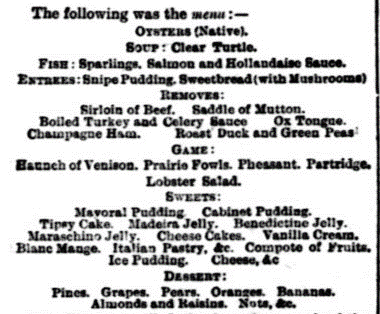
Later in the year there was a presentation to Alderman John Bickerstaffe as the retiring mayor. It was the year when the consideration of an Eiffel Tower in the town was concluded with the distribution of shares, and it was an occasion of speeches oozing eulogy and the usual self-congratulations of the gentlemen present in which Ald Bickerstaffe was presented with an inscribed ‘silver salver with wine ewer and four beakers’ after a meal which consisted of the following content;
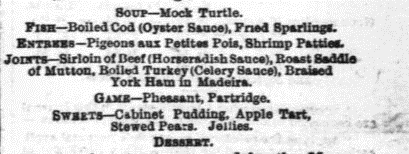
In November of 1905 John was present at the traditional mayoral church-going at the Bethesda Chapel for the newly elected Mayor Councillor Broadhead.
On the 10th November 1907 he was present at Ald J Battersby’s, Mayor’s Sunday, when the mayoral procession at Sacred Heart Church was of such proportions as to need the supervision of the Chief Constable Joseph Derham. It included members of the military, the lifeboat band and virtually all the Council members and representations of workers in a flamboyant and musically accompanied procession. Leaving the Town Hall it took the long way round and the long way round back again after the service, proceeding, on the way there, along Clifton Street to Abingdon Street then into Talbot Road and up to the church with all the pomp and ceremony and public interest that a flamboyant civic event could muster.
In November 1909 John Wray was present at the Mayor’s (Councillor T Fielding) civic visit to St John’s Church in all the same, proud traditional pomp and ceremony beginning in a procession from the Town Hall.
In April 1910 he was present at the Town Hall for a meeting to consider a testimonial to ‘Mr Blackpool, ‘Mr Charles Noden, who was retiring as advertising manager of the Blackpool Corporation due to ill health. He had been in the position for 35 years and had successfully promoted the town during that long spell. Charles Noden would eventually be a permanent resident of the cemetery at Layton on his death.
For Mayoral Sunday in 1909, the event took place at St John’s Church for re-elected mayor Thomas Fielding as all Blackpool, it seemed, had turned out to watch the pageant and the procession to the church as Town Hall officials, fire brigade, yeomanry and lifeboat and other brass bands and the 3rd West Lancs RAMC which was the medical arm of the military which would soon, at the outbreak of War in 1914, make their home in the town, and Boy Scouts and the route festooned with banners and ribbons. Quiet natured as John Wray might have been he enjoyed a bit of pomp and ceremony as he joined in the processions as cemetery Registrar representative.
~~~~~~
To return to his cemetery duties, on the 1881 census return, John is the Registrar of the cemetery and living in the accommodation on site. There are five children at home, all of school age apart from the youngest and there is room to accommodate a domestic servant too. The work of the registrar was a varied one for, along with the concern of those buried in the cemetery there was also the importance of the physical appearance of the grounds and its developments. There was a controversy for several years (at least from 1888) over the size of the salary of the Cemetery Registrar as there was over that of the Deputy Town Clerk and both were considered as, ‘Both are faithful and highly efficient servants of the ratepayers and both at present are miserably underpaid.’ (Fleetwood Chronicle 27/4/1888). His salary in this year was £75 per annum (£8,014.08) and there were actually three women on the Council books at this date, these all being librarians. By 1890 it was Dr Kingsbury who was attempting to get the salary of the registrar legitimately increased so there was still concern at this date.
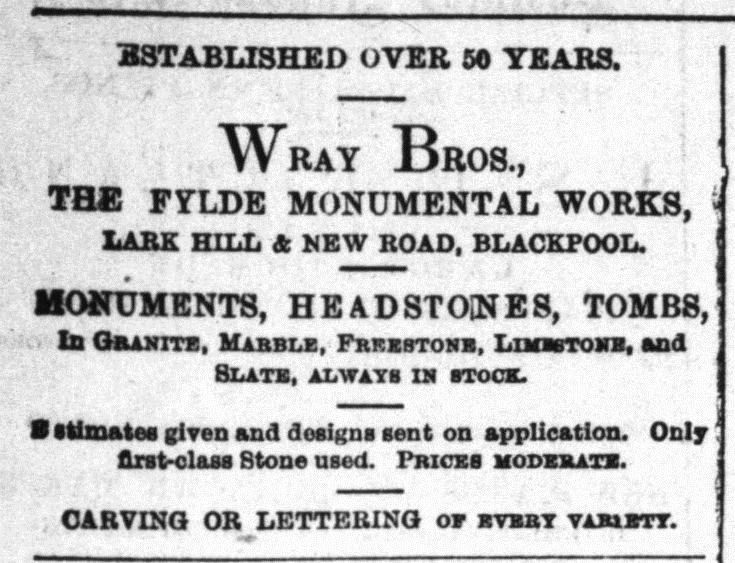
On May 1st of 1890 the celebrated occasion was the ‘Grand Exhibition of Arts and Industries’ at the Winter Gardens which included arts and crafts and collections of curios of art science, music and industry, and where there were over 200 exhibitors of the rare and curious, old and modern objects and artefacts, and a whole range of arts and crafts and called the ‘Blackpool and North West Lancashire Exhibition’. It had been conceived by the ever inventive and imaginative William Holland, managing director of the venue and arranged by a large committee of local men and women. That other well known person in the name of Mr J R Huddlestone became secretary of the Exhibition organisation. A similar exhibition had been held annually for two or three years, at Raikes Hall by the YMCA but had not continued due to the collapse of the Association. The whole of the venue of the Winter Gardens was used and in the Floral Hall, ‘From Messrs Wray Bros Fylde Monumental Works Blackpool, we have a pretty well executed specimen of monumental work in white granite.’ Alongside the Wray Brothers stall were patent umbrella holders, a dentist, an advertising agent, patent steel card cans and Bovril drinks available for 3d (£1.32) a cup. In the other dedicated areas of the venue, the Pavilion Promenade were arranged, with their commercial creators, brassworks, ironmongery, photography, engraved glass, musical instruments, automatic washers, gas stoves, fire extinguishers, and a stall in which eight girls would demonstrate the manufacture of dolls from raw materials through to finished product. Here too was Mr A Monk, (as printed, but which should read Monks) optician, of 12 Duke Street in the town and with a stall on the north pier, and whose eight year old daughter Annie was itching for the stage and would become a diva of the Musical Halls as the renowned Victoria Monks. In the Pavilion itself there were, among others, paper hangings, optical goods, basket ware, shaving apparatus, lace work, embroidery, glass blowing and Mr Kirtland’s music stall at which he had brought an organ especially up from London and which he would demonstrate from time to time during the day. In the smaller area of the Victoria Vestibule there were oil paintings, fancy goods, optical equipment and antique furniture. In the (roller) Skating Rink which was ‘illuminated’ with electric light there were more gas stoves, fruit, furniture, lifeboat models including that of lifeboat designer Mr Allen of St Annes and what is described as huge block of coal from Mr T Anderton, coal dealer of South Shore. There were domestic machines from Birmingham which included sausage, mincing machines and coffee mills and also golf equipment, and a demonstration of golf balls in manufacture, and also cycling, ‘all the most modern and popular makes’, and printing and letterpress machines. Up on the Skating Rink balcony was an exhibition of artwork by named artists from Mr David Motley’s Art Gallery in Adelaide Place in the town. The Victoria Hall was set aside for work done by children and apprentices and for which prizes were awarded and this included a variety of handicrafts, fairly divided into age and skills, and even a handwriting competition for various age groups with a pre-set poetic script. (From the Fleetwood Chronicle 2nd May 1890 and Blackpool Herald 9th June 1890). The Exhibition was held to promote and justify Blackpool town’s motto as ‘Progress’, which indeed it would have done.
In 1891 the census returns show that John is resident with his wife Mary and family at the New Road cemetery and he is described as the cemetery registrar and also a monumental mason. John and Mary have nine children living at the address. Two sons, Richard and James, 22 and 19 years old respectively are described also as monumental masons, so no doubt many of the early graves are the work of the Wray family. To the west the next property is the Queen’s Hotel and the neighbouring property on the other side is the sanatorium, now rebuilt in brick yet later again to be demolished and rebuilt with greater confidence and purpose on a new site as at this time it occupied a poorly drained part of the cemetery grounds and was treated as the pauper of Council spending it seems. The master and matron of this sanatorium are James Robinson and his wife Elizabeth, though for not much longer. On both the 1881 and 1891 census return, while John Wray is a Kirkham man, James is a Yorkshire man, quite somewhat coincidentally born in …. Wray! Unless of course, the census enumerator was on such a roll in writing the surname Wray of the several children of Mary and John that he wasn’t able to come to a stop on the following line. In 1893 John and Elizabeth were dismissed from their posts at the Sanatorium as the controversy over its running and its efficiency continued to haunt the Corporation.
1892 saw the death of popular Blackpool footballer Harry Woods at the young age of 27. He was a great favourite with his team mates and supporters. Born in Colne he was buried in Accrington and worked in the mills as well as playing as a footballer. It was not the money dripping football of today but nevertheless a sport with the same elements of loyalty, rivalry and clanmanship within teams and supporters that are natural sentiments of collective sport. At first playing for Accrington Grasshoppers and East Lancs teams he was persuaded to join Blackpool in 1889 and where he became a very popular player. His sense of duty reached a commitment of almost Monty Pythonesque loyalty when he stayed on the pitch during a game at Bury in which he had severely injured his shoulder. He stayed until the end of the game, spurning medical assistance, and the injury, it was later speculated, had influenced his death soon after when he was confined to bed, though in good spirits to those who visited him. His disregard for injury is also reflected in an incident in another match when the goalkeeper, Briscoe, was injured and left the pitch, he claimed that he shouldn’t have gone off and, ‘He was payed to do his duty and so long as he could stand up against the goalpost, there was always a chance of him getting in a kick for his side’. He was described as possessing a good nature and a ‘kindliness of heart which was always his chief characteristic, though hidden under a rough and rugged exterior’ which may have revealed him as a bit of a bruiser on the field as well possessing that do or die attitude and adhesion to loyalty within himself. He left a pregnant widow and child and there was a rush of sympathy towards him, and a collection via a subscription fund set up in the Winter Gardens, resulted in an amount of £165 2s 9d (approx £17, 234.78) being handed over to Mrs Woods. The funeral which took place in Accrington and the burial at the cemetery near the ground when the football match taking place between Accrington and Stoke, extended its half time until the burial was over, was attended by many friends and team mates from Blackpool including the lifeboat family the Parrs, four of who had played alongside him in the team. There was a large contingent of workers, the ‘warpers and winders’ from Higham Mill where he worked as a twister. Wreaths and messages of sympathy were in abundance including one from John Bickerstsaffe president of the club, and the Blackpool football management team and John Wray himself. The match between Witton and Blackpool at Raikes Hall in the days before Bloomfield Rd, was postponed as was the reserve match on the day. Donations to the subscription fund included a match between Blackpool and Accrington at Raikes Hall which Accrington won 5-4 on a slippy pitch after a recent thaw in January. In the cup game against Sheffield United at Raikes Hall on January 16th when the snow had to be cleared from the pitch before the game could be played, the players wore black arm bands in memory of Harry Woods. The game for Blackpool was lost 3-0. Perhaps even Harry could not have made a difference against a very good Sheffield side in front of the 2,000 spectators lined against the railings. Modern football, and its footballers, of course, can be considered an entirely different game. But the Wrays, senior and juniors in their interest in the football demonstrated that their feet also trod the common ground.
In 1893, William Strickland, who had been employed at the Layton Cemetery under John Wray was appointed registrar to the cemetery at Poulton.
In 1900 the cemetery was extended and with the necessary excavation works, what was considered an ‘antiquarian find’ was unearthed. This appears, as described, as a stone axe six inches long and three inches broad. The stone head has been drilled in order to accommodate (what would be) the wooden handle. This was discovered about three feet below ground level on top of the other find of what was considered to be a section of cobble road like that which was speculated at the time to be part of the Dane’s Pad which pops up every now and again in the Fylde and has no definitive age or function but assumed to be, without serious investigation, part of the system of roads which existed in the (sparsely populated) Fylde in Roman or pre-Roman times. While the Dane’s Pad, in some shape or form or description, could be proved to exist at some time as parts would still be underground yet to be discovered and seriously investigated, it is not known at time of writing, what has happened to the stone axe head.
By 1901, when his position was under review, his term was continued for another twelve months at his present salary. Three sons are no longer at the address and the address is given more formally as the Cemetery Lodge.
On the 18th February 1904 as a monumental mason he was responsible for the erection of the statue of the late Queen Victoria in the entrance to the Town Hall in Blackpool, sculpted by ‘Major’ Walter Merrett, sculptor of busts of heads of state, and assistant sculptor to the Queen and also a Freemason and who had been commissioned three years earlier. There had been a delay in its completion as a flaw in the block of Carrara marble had been found when the work was well under way. The statue and pedestal had arrived in Blackpool by train in several large packages. The statue was 8’ 10” tall and on its arrival at the Town Hall there was a great debate among members of the Town Hall as to its ideal and most advantageous placement. Major Merrett was there to supervise the positioning of the statue and John Wray and assistants were to do the physical part of moving it. It was eventually decided to put it at the foot of the staircase, where it still stands, but other positions had been considered and even getting Mr Unsworth, the mayor’s attendant to stand on the pedestal to get a realistic aspect before the final placement was agreed. The pedestal is inscribed, ‘Victoria R and I 1813-1901’ ‘She is represented in the robes of the Order of the Garter, with the chain and jewel of the Order. In her right hand she holds the sceptre and in the left the orb. From the crown falls a beautiful lace mantilla. The front of the dress is treated as representing a covering of lace over the material; while the cloak is represented as of rich velvet. On the right arm is worn a bracelet bearing a portrait of the late Prince Consort. The representation of the textures of lace, silk and velvet without looking stiff, has entailed a large amount of labour, and none but a sculptor of the highest order could have accomplished such admirable detailed work. The sculptor has been most particular in even the smallest details owing to the statue being in a position as to be closely inspected from all points.’(The Blackpool Times February 14th 1904).
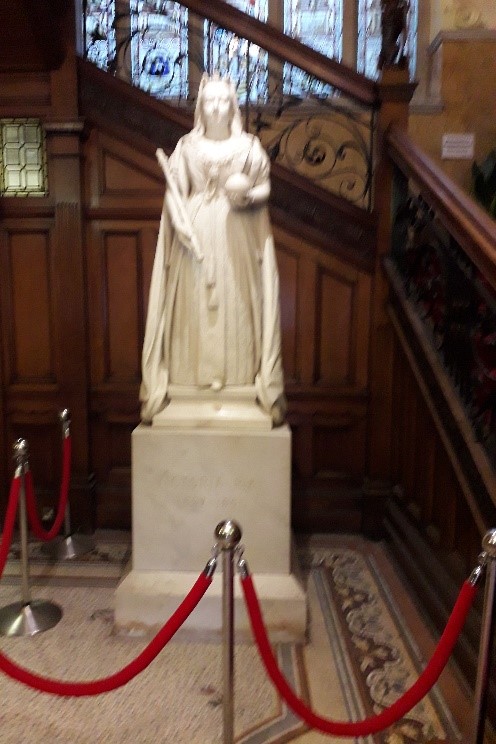
By 1905, in a newspaper column praising the longevity of the service of advertising manager Charles Noden’s 26 years, there are only two other employees who have clocked up a longer service record and these include John Chew, gas manager, and John Wray cemetery registrar.
In this year, as well as the change of Matron to the sanatorium as matron, Miss Brown, left to take up a post in Liverpool, there is the mention of the recent introduction of a small, annual fee for grave plot owners which has allowed the Corporation gardener, Mr George Rockcliffe, and staff, to pant flowers, among his other duties upon the grave plots. In this sense, the Blackpool Herald can proudly claim that, ‘God’s Acre has been wonderfully improved.’ And it continues in another column that, Just now the Cemetery is filled with the bloom and the fragrance of the roses.’ These roses, described as ‘mostly old fashioned’ include the ruby-coloured variety of Jacquenots, the red and white of the Yok and Lancaster’s, the Cabbage Province (‘the Provencal rose of Shakespeare’), the Monthly Province, the old fashioned moss roses and the more modern hybrids and the lovely Baron Rothschild ‘makes a fine show, but all so sweet-smelling that the atmosphere is filled with their fragrance.’ Around the sides of the cemetery there is an equal display of bright flowers and ‘the flower beds are ‘a blaze of colour’ and include geraniums, violas, Canterbury bells, ‘legion of honour’, marigolds and many others. The paragraph ends with a eulogy of the graveyard; ‘It is a very pretty place, therefore, as one always likes to find the place where our loved ones sleep their last long sleep and, in the absence of a Park, one cannot wonder that the Blackpool Cemetery is frequented as though ‘twere indeed a park on Sunday afternoons.’. It would be a couple of decade before Stanley Park, the town’s park wold be created.
In August 1905 the body of 9 year old James Adie of 138 Peter Street was buried at the Cemetery. He had drowned while swimming in a pit in Layton near the cemetery ‘in one of James Ward’s fields on the easterly side of Layton Lane’ (now Layton Road). It was one of those daring things that young children do when away from parents, experiencing life for themselves without guidance. He had been seen by friends who had advised him not to go swimming as he might be found drowned. He had taken off his clothes and sailed out on the back of an old door with a stick as propellant but then got into difficulties and, frightened, overbalanced and fell off. Another boy took off his clothes and waded out as far as he could but couldn’t swim and was unable to reach him. Others in alarm had arrived by then and ran for help and found ‘Prince’ Wray who was the son of the cemetery registrar John Wray and who lived nearby and who could have possibly seen the frantic activity in the field opposite from the cemetery monumental works. He arrived and dived into the water but after several attempts had to give up. Peter Callaghan of Thomas street also arrived and stripped and jumped into the water two or three times in attempt to reach James but got tangled up in some wire at the bottom and became stuck but another lad, James Cavanagh, also of Thomas Street, then jumped in and managed to rescue Peter who had by now been under the water for about two minutes. He was dragged to the bank where, frothing at the mouth, he was given artificial respiration by police constables Foster and Keenan who were on the scene by now and, after about half an hour, he was resuscitated and taken to hospital. James Adie’s body was recovered by using grappling irons, which took until about 7pm. The pit sloped down from the outside to reach a fourteen foot depth at the centre and since the land was privately owned and in reality though the boys should not have been there, there was no case for expecting the owner to fence off the pit as it had to be open for the cattle to drink from. The pit, one of numerous clay pits in the town and attracting many a young lad into their dangers is now built over, the dramatic scenes of acute tragedy and highly commendable and instinctive, personal bravery now just an echo on a printed page. The cemetery was a sad place on the day of the funeral, parents, family and friends in attendance, those closest to the loss of the young life, for ever having to accept and live with that loss. It was and it still will be, such as life is, that some will survive and some won’t as different dangers present themselves in the different natures of the ages that follow with the consequent, deep sorrows of those left behind to cope.
As the compiler of this I, and friends, used to take a short cut home from school past ‘Danger Deep’ a pond, known by many in the Layton district, formed in a clay pit in the brick croft at Layton now occupied by Warbreck school and surrounding houses and which invited fear as it was passed, perhaps echoing the life that was lost of the son of champion swimmer Joey Nuttall (who now rests in Layton cemetery) in the vicinity while employed in extracting clay for the nearby brickworks, an extraction which created the brick crofts and clay pits and which naturally turned to ponds when left, in the first place. Unfenced, Danger Deep, always reflected a quiet and sombre menace in its stillness, a kind of Celtic reverence to the deep unknown of the subconscious mind, morphed into gods that hold all the power and influence over the mere mortal human being.
The Wray Bros did not have the monopoly of monumental works business as only down (or up) the road westwards W M Cookson also had a stone memorial company on New Road and advertising by at least 1905. But perhaps the Wray Bros elicited the most popularity for, from the Fleetwood Express June 12th 1900 ‘MESSRS WRAY BROS, monumental masons, of New Road, Blackpool, are not only well known in Blackpool, Fleetwood, and the Fylde District, but we hear they have received orders from various parts of England, and as far south as Bromley, in Kent. A specimen of their work has recently been erected in the Blackpool Cemetery, a monumental stone of Aberdeen granite, and a marble statue, twenty feet high, which is artistic in every description.’ Sometimes the accounts for work done don’t get settled for a long time by the Council. For a tablet produced by the Wray Bros and erected in St John’s Market in 1894, the payment wasn’t made until February 1906. I suppose better late than never. The firm is included in the list of businesses published for Christmas 1907 in the Fleetwood Express;-

In this year of 1907 the Messrs Wray bros are credited with creating the memorial and its inscription to Alfred Halstead, journalist and for the last twelve years editor of the Blackpool Times. He was a native of Burnley and for some years had contributed to the Leeds Mercury. He was only 54 years old. The memorial of Carrara marble erected above his grave was created by the Wray Bros, ‘In the execution of this noble tribute Messrs Wray Bros have done their work well. The work comprises of a full book open at the last page on which there is a spray of laurel and is inscribed; ‘Lent, September 28th 1852. Returned May 1st 1907’. The last three pages are shown torn to represent the last three years of his life when he may have been subject to some degree of Alzheimer’s as the newspaper (Blackpool Herald) describes those last three years as ‘failing mental powers’. The memorial scroll on the pedestal and as published in The Fleetwood Express Nov 20 1907, for one of their own, reads;-
ALFRED HALSTED
Journalist‘
“Thy mind shall be a mansion
For all lovely forms
Thy memory a dwelling place
For all sweet sounds and harmonies”
For Thou, O Spring! canst renovate
All that high God did first create,
Be still his arm as architect,
Rebuild the ruin, mend decay.”
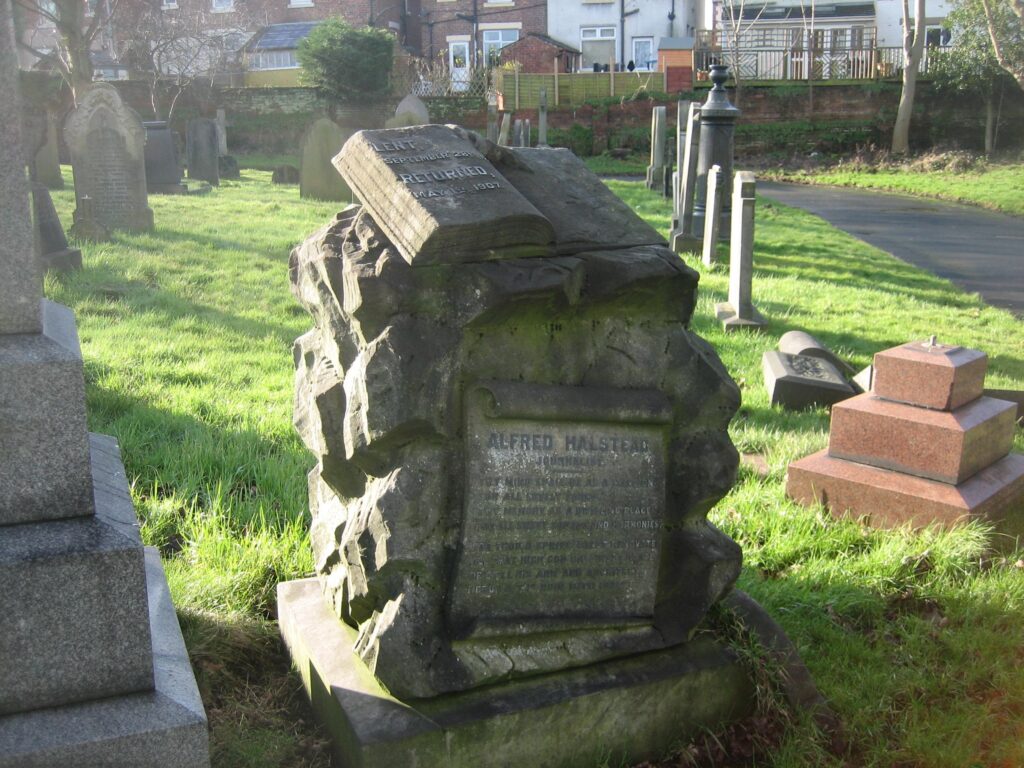
There are several monuments in the cemetery created by John Wray and the succeeding Wray Bros. Another identified piece of monumental masonry would have been found in the Bethesda chapel and a dedication to Gunner Observer Joseph Henry Bolton of the Royal Flying Corps who was killed in action in France on April 5th 1917 and the tablet commissioned by his mother. The tablet was of white Cicilian marble on a black marble background. Highly polished the white section bears the emblem of the Royal Flying Corps. It is not known at time of writing what has happened to this tablet.
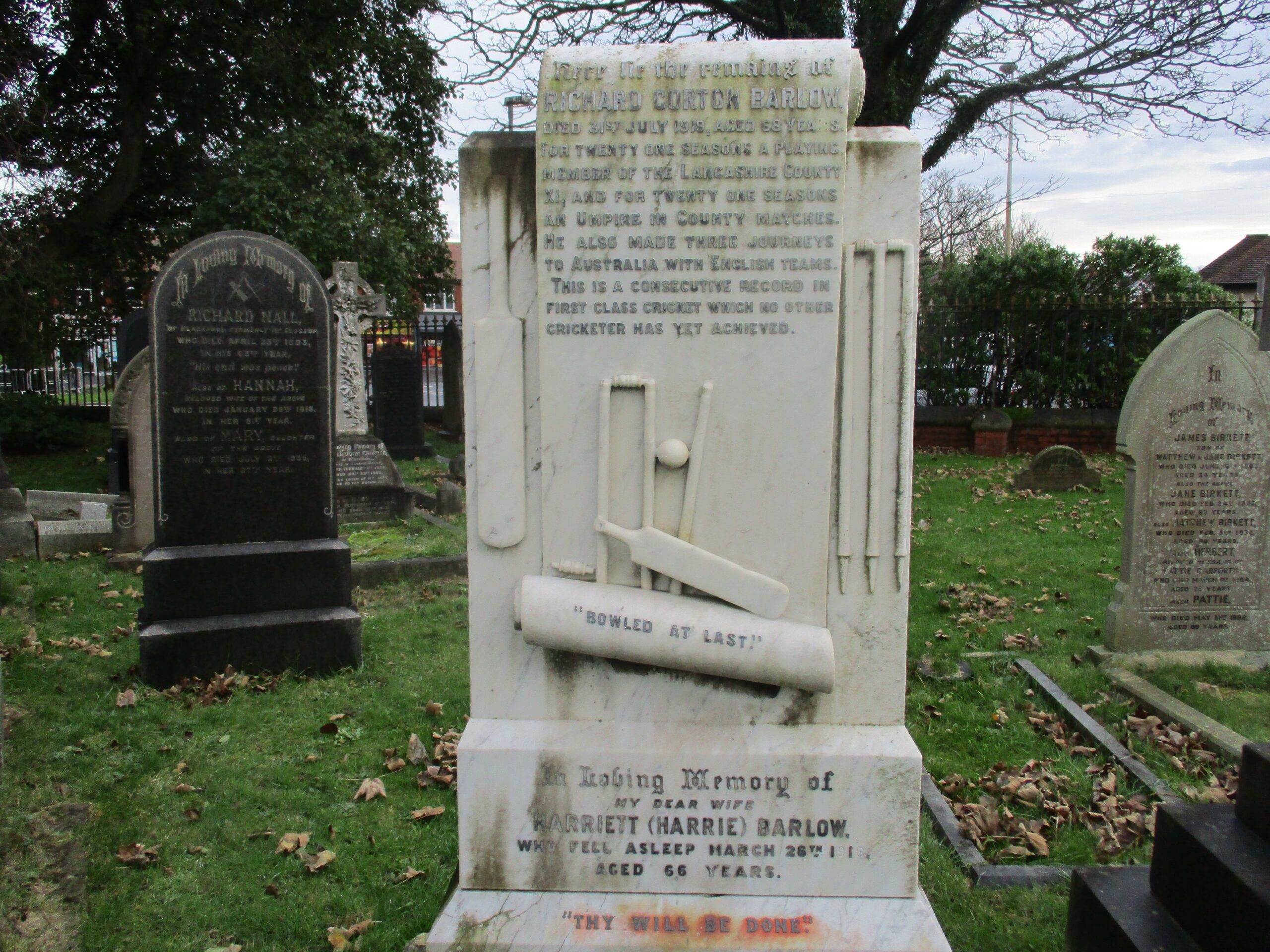
The monuments were created in the yard at New Rd and could be viewed publicly as they were under construction. That of the cricketer RG Barlow, whose stubbornness at the crease, would be reprised by Geoffrey Boycott in his own day, was such a monument with its cricketing paraphernalia, commissioned by the cricketer himself, was a feature of public interest before being erected in the graveyard at the appropriate time. Much transparent symbolism and some arcane, is represented in the graveyard carved into stone, as observed by a journalist in a stroll through the cemetery in 1914, and consisted not only of cricket wickets but lifeboats, telecommunications, journalism, musicianship, blacksmith, heroic deeds of self-sacrifice, a walking stick manufacturer and engine driver all of which show not only the skills of the stonemason but the regard in which the memory of the deceased person is held by those commissioning the work. In May of 1908 there was distressing incident when the wrong grave had been opened to take in the infant body of a funeral being conducted in the mortuary chapel, causing the interment to be delayed. The mistake was discovered when a Miss Jackson arrived to place flowers on her father’s grave only to find it had been opened. On enquiries to John Wray, it was discovered that there were two people of the name Jackson in close proximity in the cemetery and the mistake had to be remedied immediately. Easy to talk about now but distressing for all involved at the time and extremely uncomfortable for John Wray himself as the man with ultimate responsibility.
On 18th August 1909 a hot, sunny and successful weekend when 68 special trains had brought in 30–40,000 holidaymakers, it was followed on Monday morning, about ten o’clock, by heavy rain and a thunderstorm, and the lightning associated with this not only struck local resident Mr Ellison when he put up his umbrella, and thus burnt his skin and blackened the keys and chain in his pocket, and also striking and killing a valuable horse while grazing in a field in Thornton, it also damaged the spire of the C of E chapel in the cemetery at Layton. John Wray who, it is reported, lived opposite the cemetery, (so now residing across the road at his Monumental works), saw the damage on looking out of the window and his son John Wray jnr from his home close to the cemetery on New Road and probably a property next door to the Monumental works, witnessed the damage when a flash of lightning tore out a gap of several wide feet wide in the masonry of the spire ‘enveloping it in a bluish flame’. Some masonry crashed through the roof of the building covering the floor with debris and the iron downspouts were smashed as well as a garden bench outside, which was broken in two. The lightning when it reached the ground created a hole two or three feet deep. However the lightning didn’t affect either the Catholic or Nonconformist chapels either side of it nor the Corporation workmen who were sheltering in the porch of the latter chapel only 30 yards away. The steeple didn’t have a lightning conductor but there was a 12ft iron rod affixed to the steeple from the vane at the top and it was concluded that the lightning grounded here at the end of the rod in the middle of the steeple, and that the upper part of the steeple would have to be pulled down and rebuilt. By Tuesday morning a report was submitted to the cemetery committee by John Wray as to the extent of the damage and so no time was being lost in making good the repair. The cost of the repair due to the lightning strike was quoted as £100, though it was insured and the ratepayers would not have to withstand the full cost.
In 1909 there were 611 burials at the cemetery against 570 the previous year. The total expenditure including interest of £800 (£78,284.94 ) on loans amounted to £2,087 (£195,712.34) and the income being £1492 (£146,001.41).
In January of 1911 the extension to the cemetery created earlier was about to be planted with about eight hundred trees and would include elm, sycamore, poplar and willow and the work would be undertaken by George Rockliffe the Corporation gardener, always no doubt conferring with the cemetery registrar, who was also referred to at this date as Parks and Cemeteries Superintendent.
On the 1911 census John Wray, by now 69 years old, is a Parks and Cemeteries Superintendent. His address is New Road (later changed to Talbot Rd) and his house has nine rooms as per the criteria used for the number of living rooms, bedrooms, and including kitchen, in the abode. So it can be understood he is living across the road from the Cemetery, with plenty of space but devoid of the sound of children as there is only 30 year old, and unmarried, daughter, Jenny Jane at home with her parents. Of the nine children born to John and Mary, three are written as having died by that date.
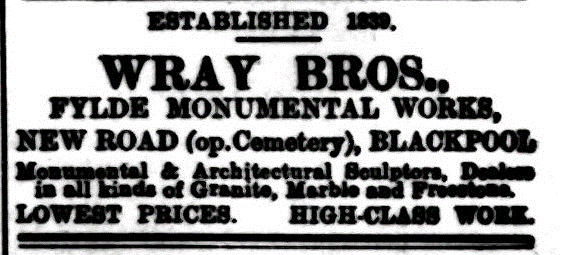
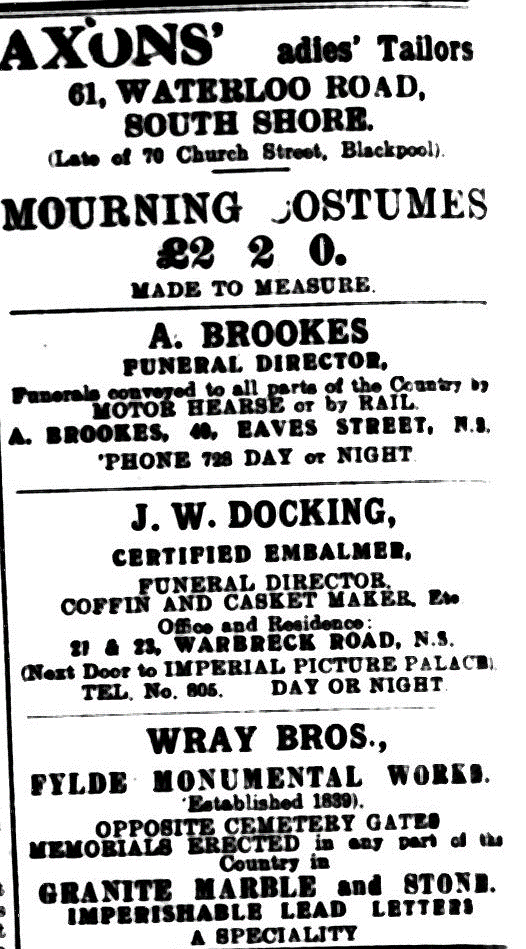
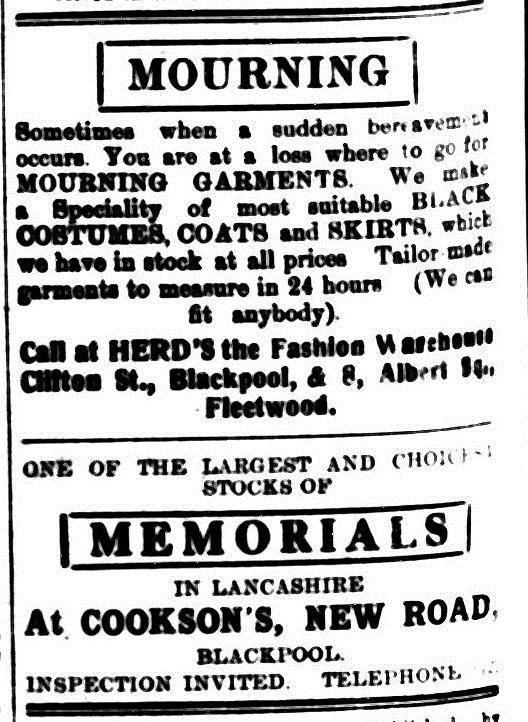
Late on the Thursday night of August 24th 1911 a tramcar ran into the wall of the cemetery which was at the terminus of the New Road-Layton line, or the ‘dead stop’ as it was locally and colloquially referred to. Instead of taking the loop to the left, it had jumped the points and careered across the road, gauging the asphalt footpath and ending up embedded in the garden wall of John Wray’s cemetery house, demolishing about ten feet of wall and fencing. Of the passengers on the tram at the time no-one was hurt but some fairly frightened. The tram itself was too far from the overhead cables for the trolley to reach so it was necessary to bring another tram to pull it back on to the track and reconnect the trolley. It was a late night for the workers, and no doubt for the Wray household as the tram was not back at the depot until the early hours and there would have been much activity outside the house at the time. It is not certain whether the house referred to is that within the cemetery grounds or the more substantial building across the road.
On the 6th October of 1911 he attended the funeral and interment of ex-mayor James Howarth at the cemetery who had attended to the needs of that other, obscure but renowned, American cemetery resident, George Washington Williams in his brief association with Blackpool. In December of this year the Wray Bros advertised in the Blackpool Herald a, ‘Good Modern HOUSE adjoining Wray Bros Monumental Works, half acre spare land attached – apply Wray Bros New Road.’ The Monumental works were in competition with Cookson’s monumental works also on New Road a little further west of the Wray Bros premises and advertised in the local press.
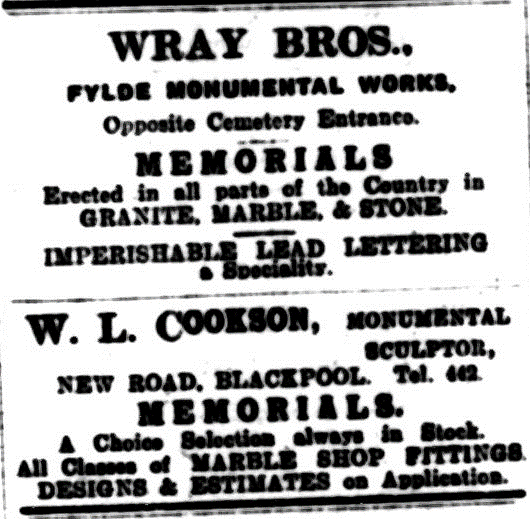
In 1911 ‘a marble commemorative tablet, recording the opening of the Library by the Mayor, and containing the names of the Committee, and the Building sub-committee, is to be prepared by Messrs Wray Brothers of Blackpool and placed in the Entrance Hall of the New Library.’ The Carnegie Library and Grundy Art Gallery were opened on 26th October 1911 in a grand ceremony. At the time the library had the address of Maybell Ave (now Abingdon Street) and the Art Gallery with its present address of Queen Street.
In April 1912 a woman named Lavinia Eastwood was caught stealing growing flowers from the cemetery. It was Charles Noden, Blackpool’s first advertising manager who just happened to be walking past the cemetery on New Road when he had seen her pick the flowers and put them into her bag. These were six hyacinths, no doubt exuding the pleasant aroma of springtime and which were growing upon a grave. Charles Noden immediately went in to inform John Wray who sought out the woman and challenged her. She at first denied the offence but when she opened her bag when asked, the hyacinths were revealed and she pleaded with him not to tell since she would probably be locked up and she had a family of eight to feed. But he had told and when Detective Ashcroft arrived he found a bottle of stout and some penny items in the bag. She was a woman with previous convictions for various minor offences but who had a propensity to drink and was under a probation order at the time to abstain from drink, a weakness which her husband claimed he was unable to control in her. When up before he magistrates who considered they should ‘knock some sense into her’ since she couldn’t do it for herself, and the probation office had given her every assistance, she was given a month’s imprisonment and a 1s (£4.84) fine and costs or seven days, these two custodial sentences to run concurrently. She left the dock in tears, such is the nature of regret relevant only to sobriety.
In the same year of July 1912 there was the tragic death of 7 year old Frank Brown in a road accident involving a cart. Frank was returning home at lunch time from the Adelaide Road School and dashed into the road, without concentrating it seems as the young mind is often dangerously occupied by daydreams, and fell under the wheels of a horse driven cart. Thomas Wray was first at the scene on Coronation Street. The inquest was keen to understand that the driver was competent and was driving sensibly and he was subsequently cleared of any carelessness and his horse, his own, was a steady one. He was going at a slow trot and could have easily pulled up if he had seen the boy run out. He had been sitting on the left side of the cart and when this was queried that it was the wrong side of the cart, the evidence was that the step was fixed on the left side and if he had been on the right side then he would have seen the boy run out anyway. It was seemingly correct positioning on a slow cart for the driver to sit on the left but for a fast moving vehicle for the driver to sit on the right side. He first he knew of the accident when he heard the screams of some women at the roadside and looked back to see a man picking up the child in his arms. Thomas Wray had sent for a doctor and an ambulance carriage, and meanwhile had washed the blood off the boy’s face seeing that he was badly injured around the neck. He accompanied the boy to the Victoria hospital on Whitegate Drive in the ambulance, but the unfortunate boy sadly died on the way there. A witness said he had seen the cart and the lad attempting to cross the road from behind a Council dust van and run out into the side of the horse, falling under the wheels as the horse had stepped over him. And so for those to who fairness is not dished out in generous quantities, his mother Norah already a widow at a young age had to cope for the rest of her life with the deep sadness the loss of the treasure of a young life she had created herself.
In June of 1912 John Wray being closely connected to the Parks Department where the cemetery grounds were supervised by the Registrar but worked by the Parks Department, he was the undersigned to contract for the erection of hoarding around the Central Drive Bowling Green.
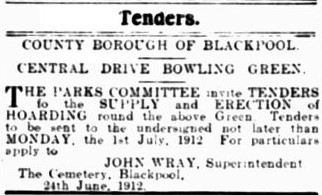
At the end of the year, at the ‘at home’ event for the incoming mayor Mr John Collins at the Town Hall, it was Mr Tom Wray receiving accolades who, in the words of the Mayor, and quoted in the Blackpool Herald of the 25th October 1912, ‘The town Hall looked really charming with its wealth of floral decorations, palms, plants, and beautiful ferns and flowers arranged with really exquisite effect up the grand staircase, the corridors, and within the ante-room and Mayor’s parlour. I must really compliment Mr Tom Wray, the Deputy Cemetery Registrar, and his assistants for the very beautiful display they made of plants and flowers in all the five rooms which were in use during the “At Home”. I am told that the flowers and plants came from the nurseries belonging to the town, showing the excellent care which must be taken in that department.’
On Monday 4th February 1913 a reporter from the Fleetwood Chronicle went to interview John Wray to congratulate him on his forty years as cemetery registrar and was able to learn from him some events from his life and publish them in a column in the newspaper the following day. It was a life that would soon be at an end for, on Good Friday March 21st 1913, John Wray died at his residence, Cemetery Villa, New Road. He had contracted a chill while exercising his duties and which developed into influenza and kept him to bed for a couple of weeks. Though he improved, and his improvement was reported in the papers, and he also got over a weak heart condition, he had a sudden seizure on Good Friday morning. Though attended to by his family and his doctor, Dr Sweeney, he died at noon.
An assessment of his character, as reported, is given as a quietly spoken man who was a much better listener than a conversationalist. Though not reluctant to speak, his quietly spoken voice which was a friend to all, and his compassionate and listening ear rendered the world within the gates of the cemetery, a quiet, reflective and sympathetic place. ‘No mourner e’er so poor, be left the object of his or her tears into more sympathetic hands than those of John Wray – and no footsteps ever patrolled the area of sacred groupings with more thoughtful respect than he did.’ In the privileged status that the hard work and enterprise of his family, and indeed his own, had created for him, he didn’t appear to have lost a sympathy for others during his life and he had many influential friends and many to render a suitable eulogy on his death.
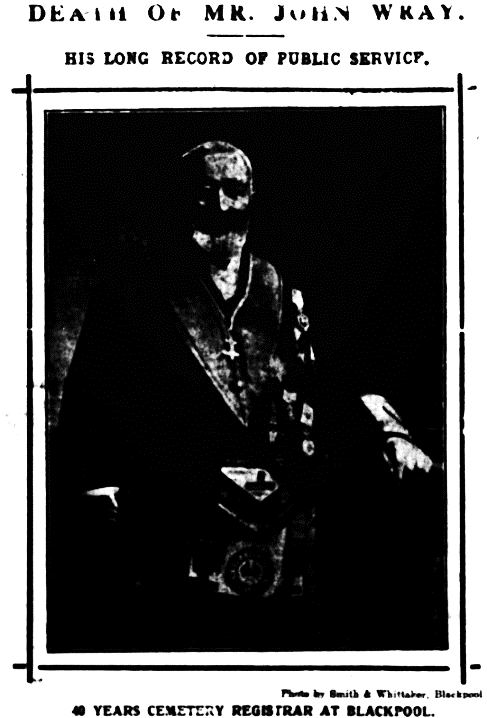
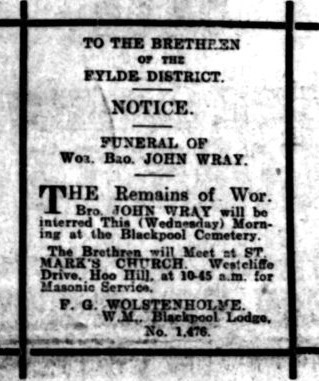
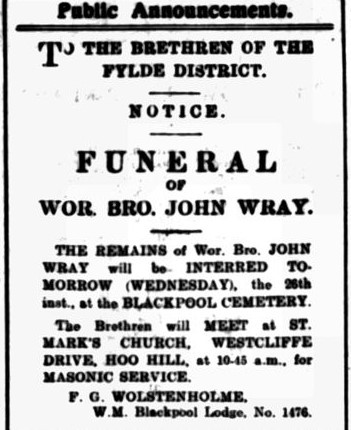
His funeral was conducted at St Mark’s church by Rev Job Edwards where a special Masonic service was held as Lodges from many parts of the country were represented. The interment took place at 11.30 on the Wednesday morning of 26th March. Crowds witnessed the funeral at which there were many Corporation and Freemason members present. At the cemetery and outside his house, Cemetery Villa, the mayor and Council officials had gathered having arrived in two draped tramcars from the Town Hall. The oak (another report states pitch pine) coffin bore the inscription, ‘John Wray Died March 21st 1913 Aged 71’ It was fitted with Masonic handles and the design of a masonic square and compasses on the lid. Such was the esteem in which he was held, he was buried in the robes of a Knights Templar. The masonic complement formed a line outside the gates as the coffin arrived and followed first to the Anglican Chapel of Repose then to the graveside where the Rev Edwards read the Masonic Ritual and offered a few words in personal recognition, having known him for twenty years. Wreaths were numerous from his extensive family, officials, Masonic brethren and well-wishers who would have known him. The remains were placed in the family vault which was purple lined and adorned with flowers among which was the masonic emblem of acacia.
At the Council meeting of early April a motion was passed to record their appreciation of the work of John Wray both at the cemetery as registrar and as his more recent post as Superintendent of the Parks and Recreations, and it was agreed that a letter of condolence and appreciation would be sent to his widow.
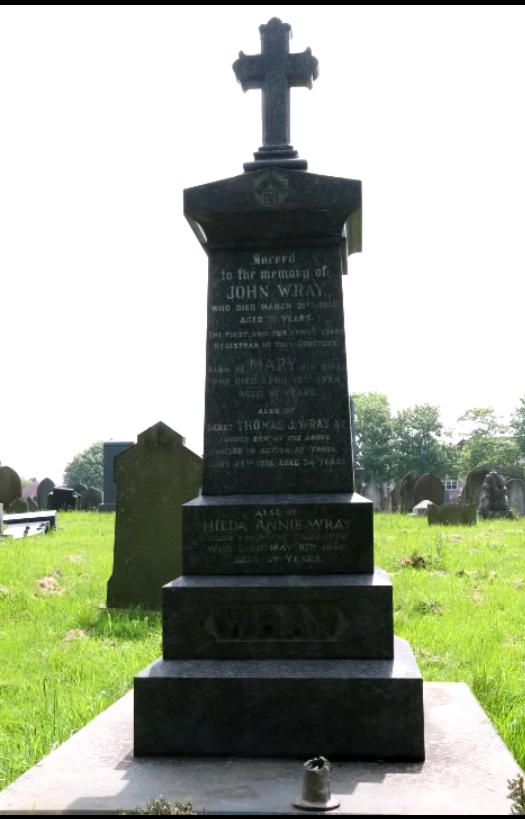
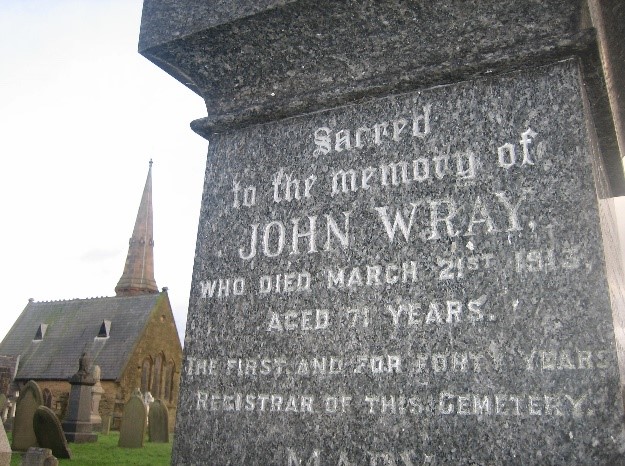
John Wray of ‘Cemetery Villa New Rd Blackpool’, left £1367 11s 8d ( approx £129,674.40) in his proven will to be distributed by his son Albert and son in law Robert Bickerstaffe, married to his daughter Lillie. But no mention of his wife Mary who would outlive him for several years yet.
After his father’s death, and by the end of April, Thomas Wray was elected as Cemetery Registrar, a duty he wouldn’t hold for a long time as the trouble in Europe, already evident would develop into all-out War, and he would lose his life amongst it. He was selected from initially 68 applicants though he had the added advantage of already holding the position of assistant registrar. One of his tasks as acting registrar before a permanent registrar had been appointed, was to advise on the position of the public memorial to the late, and first, Chief Constable of Blackpool, J C Derham and this was funded by donation, the excess of which was to fund an ‘enlarged photograph of the Chief Constable to be hung in the South King Street police station’. The memorial, a bust, had been received at the premises of Messrs Wray Brothers and there was discussion as to where to place it in the town. Outside the library was suggested and the family of the deceased Chief Constable did not want the grave itself to be modified in any way but on the previous advice of John Wray there was enough required space (9’ by 4’ for a grave) in between the grave and the path and this was the site selected for the monument. It is not known at time of writing where this bust was placed. There was also a collection for The J C Derham Hospital Cot Fund for the Victoria Hospital which was the traditional form of charitable contribution to good causes which had a usefulness across the scope of society in the days before the public funding of the NHS. At the time of the Chief Constable’s death, there had been many contributors included the Cemetery and Gardens Department of the Corporation an amount of 12s (£58.10) and that from the employees of the Wray Brothers 5s, (£24.21) in a total that amounted to £617 18s 11d (approx. £59,000) by the December of 1911.
The family of John Wray
John’s father, William George, died on 18th March 1893 and is buried in St Michaels’s Church in Kirkham. He left £161 4s 2d (over £17,000) in his will to his son John and unmarried daughter, Mary, among two others, which didn’t include his wife for some reason, and who outlived him in Kirkham, succumbing in 1907 aged 89. There was some unidentified controversy over William’s will in which Mary, the executor and defendant, was in conflict with some of William’s creditors. The 1883 electoral roll shows William owning Nos 31, 33 and 35 Church Street, No 35 which was his daughters’ drapery shop in Kirkham. Mary lived to be 80 years of age and died in 1931 and is also buried in the parish church. She had left in her will £1634 10s (approx. £91,507.31) to her sister’s family.
In his varied employment roles, William experienced varying amounts of success and failure. In 1869 as an innkeeper, he was fined 5s (£24.47) and costs for selling short measures at his inn, the Swan in Kirkham. It seems he had bought glasses in good faith which he was led to understand would hold a gill but in fact were short of that amount. In November 1870 he was declared bankrupt, which appears to have been incurred when he is described both as a stonemason and an innkeeper, but in 1874 this is annulled. So life wasn’t all that plain sailing and such is the risk entailed in adventurous entrepreneurship. In 1877 his commitment to the church is shown as he is president of the Lancashire Association of Change Ringers, church bell ringers. He was an active member of the community and an often re-elected member of the local board at Kirkham. In September of 1891, as an overseer, it was worth mentioning in the newspapers that he was thrown from his trap outside his home, by a reputably excitable horse he owned, and sustained an injury to his head as it crashed down heavily onto the cinder track that was the road surface. His home address was Church Street which contained a large number of mill workers among its residents in the mill town that Kirkham was. By 1881 William is at 33 Church Street and is a monumental mason. His daughters, Mary and Emma are dressmakers and there is an apprentice stonemason at the address, a Joseph Kenyon.
In 1891 William George was still at 33 Church Street which today is a red brick cottage evident among other white-rendered cottages. His daughter Mary a dressmaker and draper eventually had the next door address of no 35 where she ran her draper’s shop. At one time she ran the business with her sister and neighbour Emma Crane who lived at No 31. This partnership was mutually dissolved in 1887 when Mary assumed responsibility for the debts and (presumably) paid them off so it appears to be an amicable settlement. At this time her father William George is described as a monumental mason at No 33. Mary didn’t marry and died at age 80 at that address in 1931. There are a couple of notices in the papers in 1909 and 1923 regarding thefts from the shop and usually relating to drink, so nothing changes much in the evolution of those who can pay but won’t or can’t pay but need to acquire material goods for desperation or pure, selfish profit. In 1923 two Kirkham men were fined 20s (£49.71) each for stealing a woollen jumper and an undervest, valued at 12s 6d (£31.07) from the shop (one of these was named Reed, but no known connection to the writer of this). In 1909 a woman named Susannah McBride had just come out of the workhouse and went begging at the shop. She was drunk at the time so it is probable that Mary did not comply but, on a second time going into the shop, Mary was busy and didn’t see her. On this occasion she took a couple of cotton shirts sand sold them on. But she had been seen by a couple of children leaving the shop with goods and she was eventually found out and sent to trial at Preston.
In October 1907 John’s mother, Alice died in Kirkham and one of its oldest residents at 89 years of age. Her husband, as often women were described by the occupation and reputation of their husbands rather than having importance to themselves, is described as, ‘a prominent contractor at Kirkham, Blackpool, Fleetwood and Lytham’, in reference to him.
Of the children Lillie was married in a quiet ceremony at St John’s Church, Robert Bickerstaffe, son of Ald John Bickerstaffe JP, in September of 1906.
On the 25th November 1910 John Harold (‘Jack’) Wray died at his home in Cemetery Villa on New Road where, for the last five years, he had taken over his father’s monumental masonry business. He was only 32 years of age. He was an electrical engineer by trade, starting out at 14 years of age and worked with Blackpool’s first electrical engineer, John Hesketh, and was one of the first Corporation employees in this new department. In 1891 John Harold, while working for the electrical department of the town, had fallen off his ladder, while repairing an electrical cable, a drop of 25 feet and broke his arm. Later he moved to Malaga as assistant electrical engineer where after some time he caught malaria. Returning to England he found similar employment in Folkestone then after a year moved back to Blackpool in the electrical department before after five years, was appointed, out of 100 applicants, to the position of electrical engineer to the West Bromwich Corporation. From there he went to Bombay but for health reasons he was advised to return home where he took on his father’s business. A snippet of news in the Fleetwood Express from the November of 1907 pointed out that John T Wray, had the unique experience of having been born in the cemetery and had just been appointed to Cemetery Registrar of Bacup out of 50 applicants. but it is not known how long he had held this post.
His death was sudden as he was only taken ill only a week before. He was a popular man within his somewhat privileged social circle and his funeral was well attended. Wreaths were abundant and included those from his workmates at the monumental works and the Cemetery workmen, the Blackpool Junior Conservative Club Committee, and members of the Fylde Lodge of Freemasons.
The eldest son, Richard Jackson Wray, whose father William George is described as an engraver in 1869 at the time of Richard’s birth, married Susan Brightmore in 1891 at Christ Church. She was living at Raikes Hill at the time and her father is described as a ‘gentleman’.
In October of 1912 John’s youngest son Albert, referred to as ‘Prince’ and as a member of the RAOB, with the title, Primo Wray, was married at Croydon. He began his career at the depot of the Blackpool Corporation Tramway Department and then the Electricity works, and then Dick Kerr’s in Preston. In 1907 he had moved to London to take up a post as the assistant tramways manager of the South Metropolitan Tramways Company and in 1914 was appointed to the Gravesend and Northfleet Tramways Co and the Kent Omnibus Services. In 1929 he was working in Melbourne, Australia where his death was quite sudden at the young age of 46. His two children were at school there and his wife, quite tragically, was away visiting in England. As far as the direct Wray connection to Blackpool was concerned at this date, there were only two daughters of John left in the town, Miss Hilda Wray now living on Beech Ave and Mrs Jennie Murdock married on Leamington Rd.
Thomas Jackson Wray.
On 29th April 1907, John’s son Thomas Jackson Wray married Lydia Edith Smedley at St John’s Church. At the young age of 34, he was not to experience the longevity of his parents as he was to be offered up as a sacrifice during WW1 to the inability of the human animal to collectively embrace and entrust each other. In April 1913 Tom Wray, after the death of his father, was appointed to Cemetery Registrar. He was member of RAOB and was the Deputy Provincial GP in the Blackpool and Poulton Office. At the Tower Harmonic Lodge he was congratulated on his appointment. Here he is known with the title of Worthy Primo Wray as he was Deputy Provincial GP in the Blackpool and Poulton Province. It was at the same time as the Blackpool cremation society was launched in an attempt to, ‘convert the people of Blackpool and the district round about to the advantages of cremation, that the Corporation may be persuaded to erect a municipal crematorium’. This would not be realised until another twenty years or so but its beginnings were at least in 1913.
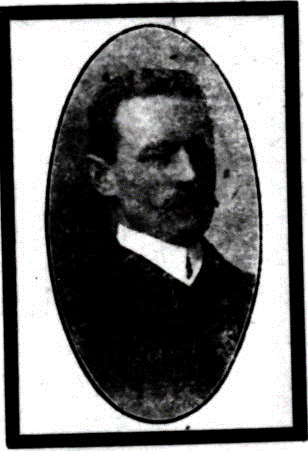
There are no WW1 records identified for Thomas and perhaps these belong to those burnt records destroyed by fire damage during WW2. The records existing are from his earlier military involvement from 1900 when possibly he was inspired to join up on seeing the proud military departure for South Africa of the volunteers from Blackpool on that cold February morning. Much of this earlier military career was spent in Hong Kong, China, so we have to rely on the cwgc commission and the newspaper reports of his death in WW1. The cwgc reads; ‘Thomas Jackson Wray deputy superintendent of Blackpool Corporation Cemetery b 1882 Service no 48542 d 25/6/1916 Brandhoek Military Cemetery. Husband of Lydia Ethel Wray 4 North Ave Blackpool Age 34. Royal Engineers.’ His rank was acting sergeant. He joined up for his second stint in the military a month after the outbreak of war, voluntarily leaving his job as Cemetery Registrar, (and living next to the cemetery) and spent some time in Chatham before a few days’ leave in April when he then went out to the Front where, during the extended battle of Ypres, he was hit by a shell and killed. Before the official notification of his death was announced, two of his Blackpool ‘pals’ had written to his wife to inform her. Their letters, in a newspaper column headed ‘Fearless in Danger’, and describing how highly regarded he was by his ‘chums’ read, (Corporal F Clapp); ‘I was the one who found him. Poor Tom never had any pain. His death was instantaneous. He was a brave man and did not fear death. He was loved by everyone. We cannot forget it. They buried him yesterday with the rest, in a place where we can and go look after the grave – I will see to it myself…. I shall never forget Tom. One of his section was missing, so he went to find him. He went four times down the road. The man was not back, so Tom went down the road again. He found the poor fellow dead. Tom saved another man’s life as well. The man was bleeding to death, but Tom was in time to save him. Nothing was said about it, but the boys will not forget. That is the sort of man that Tom was. He was a good Christian. The night before he passed away he was reading the Bible.’ Corporal H Green wrote, ‘He suffered no pain, dying immediately after being struck with a piece of shell. He was buried today at 3pm in a cemetery near here. His death was a big blow to me, for he was my best friend. It will be a consolation to you to know that he led a good Christian life out here, and he was respected by all the Company. He died for a noble cause. More, a man cannot do. God rest his soul.’ Thomas left a wife and a child. He was a former pupil of Christ church school.
Jennie married Edgar Murdock, a Catholic and architect from Blackburn whose father was a jeweller. Annie it appears remained unmarried.
1916 saw the tragic end of an ex-employee of the Wray Bros. While the war was raging and there were soldiers wounded and dying and finding their names in the newspaper columns and many an honest endeavour was recorded in assisting the war effort at home in many, varied ways, domestic life went on and, if human frailty causes war in the first place, that frailty can first be identified in the individual in civilian life. Herbert Spruce Rostron had been an employee at both Wray Bros and Cooksons on New Road, working as a sculptor. He was living apart from his wife whom he wanted back with him but she had refused. While he might not have been able to understand why, she had been the victim of his seemingly uncontrollable anger and her conditions for them to live together again had to be met. Natural anger management would have been ultimately a part of that condition, it would seem likely, and she had taken out two separation orders on him. The last time that they had met he had threatened to shoot her if she didn’t come back to him, so she had every right to distance herself from him. The second separation order had driven Herbert to take his own life by throwing himself off the North pier into a receding tide. While there were attempts by bystanders to save him by throwing the available lifebelts into the water, one by another tragedy of the war, a Belgian refugee displaced from his homeland, his body was eventually returned to the Gynn by the following incoming tide. The last person to have seen him alive on the pier described a contented, unruffled and smiling man moments before a body was noticed in the water. The next time his wife saw him was at the mortuary. Perhaps modern psychotherapy, if sought out, might have helped the man in his emotional state that could be revealed by the notes left in his pockets. Unable to blame himself or find any fault in his own actions, he had written, ‘My wife’s treatment has compelled me to find rest under the water. God forgive me!’ and in dotting the ‘I’s’ and crossing the ‘T’s’ of an otherwise organised mind it continued, ‘All my money matters are square. Respectfully Yours H. Rostron.’ The second note read, ‘I told my wife that if ever she took out a second separation order, I should not face the disgrace. She has done so, and I must end.’ At a time when a woman’s marriage vows expected her to ‘obey’ her husband it was perhaps the man’s natural assumption that hitting a wife might be quite a legitimate procedure if she disobeyed, and shame would be the alternative if she was seen to have the ascendancy over the man. Perhaps an inordinate and misplaced male pride dictated by the common understanding of the day, had ascendancy over his reason and dictated his end.
John Rainford, well established butcher and eminent judge at the annual cattle shows in the Fylde had married Alice Jackson John’s sister in law. The newspaper report of his obituary refers to her as John’s sister, an excusable error perhaps but less so the report could not even give her a name, referring only to the widow as Mrs John Rainford. (The Fleetwood Chronicle June 25th 1912.) He had at first opened up his butcher’s shop in the ‘new’ shops by Bailey’s Hotel (now the Metropole) in the June of 1887. Here in the somewhat courteous language of the day, ‘J R presents his compliments especially to the residents of NORTH SHORE and earnestly solicits their patronage as he has no doubt that a good Butchers Shop in this neighbourhood will be considered a boon by the inhabitants.’ At the same time, and advertised in the same newspaper, William Ashurst has moved his butchers premises from Birley Street to the corner of Upper Talbot Rd and Abingdon Street (No 12) so there was competition that the rival butchers had to deal with in their polite language to their customers. John Rainford later moved his business, not far away, to Springfield Road and then to Lytham Street before retiring to Hardhorn, when he left the business in the hands of his sons though still remained a member of the Blackpool Butchers’ Association.
The Wray Bros business continued and advertised further afield. In 1938 in an advert in the Lancashire Daily Post for a stonemason, the address is given as 476 Talbot Road (New Road has been renamed Talbot Road by now) so either a misprint or the premises includes two addresses extending into next door.

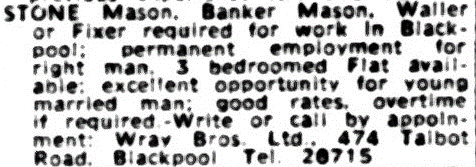
Sources and Acknowledgements
The majority of the information has come from several hundred newspapers from the British Library Newspaper Archive accessed via Findmypast and the British Library Archive site itself. Census returns have been accessed via findmypast and some parish records via lan-opc.org.uk. The Queen Victoria statue by kind permission of the Town Hall staff and the cemetery mages by kind permission of Denys Barber of the Friends of Layton Cemetery.
Mayors of Blackpool
https://www.blackpool.gov.uk/Your-Council/The-Council/The-Mayor/Mayors-of-Blackpool.aspx
Town hall Sculpture
https://sculpture.gla.ac.uk/view/person.php?id=msib5_1209422320
Commonwealth War Graves Commission
Maps
https://maps.nls.uk/geo/find/#zoom=5.0&lat=56.00000&lon=-4.00000&layers=102&b=1&z=0&point=0,0
Wray Bros Monumental masons
https://local.standard.co.uk/company/721100129132544
http://www.wraybrothersmonumental.co.uk/
Inflation calculator. All results which include shillings and pence are given to the nearest calculable amount, refer to August 2023).
https://www.bankofengland.co.uk/monetary-policy/inflation/inflation-calculator


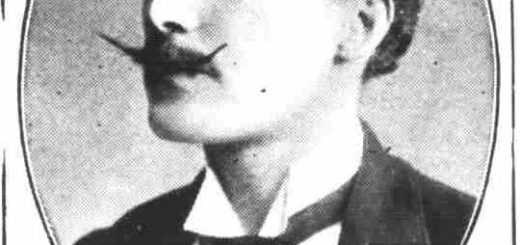
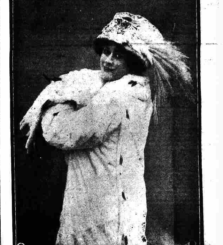

What a fascinating read, as a mason myself I found it very enlightening.
A very comprehensive read indeed !!
Thanks for your comment and glad you found it a good read. I didn’t realise that John Wray had such a history attached to him when I first began to gather information on him.